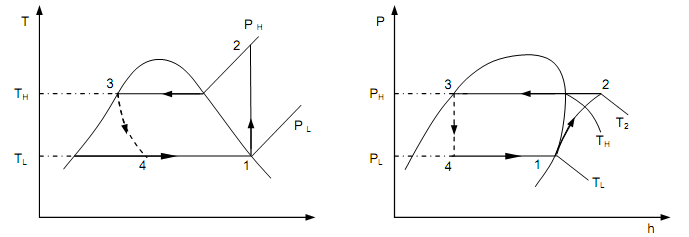Wet and Dry Compressions
The fundamental or ideal cycle for the VCRS shown in figure below is termed as the ‘Wet Compression Cycle’ since the situation of vapor at inlet to the compressor is wet. The second figure shown below is the fundamental cycle on T–s and p–h diagrams for the ‘Dry Compression Cycle’. Here the vapor comes into the compressor as saturated vapor at the evaporator temperature. The dry compression is generally preferred mainly for the two reasons as below:
(a) The compressor effectiveness is high, and
(b) No damage to the compressor by the entering slugs of liquid.

Figure: VCR Cycle (Wet Compression)

Figure: Vapor Compression Refrigeration Cycle (Dry Compression)
In the absence of any particular information, in the study of a simple VCRS, the system is supposed to work on fundamental or ideal dry compression cycle as shown in figure above. In such a situation the vapor at entry to the compressor is saturated vapor at the evaporator temperature and the compression of this vapor to state 2 is via reversible and adiabatic compression in the compressor. Also, at state 2 the pressure becomes the saturation pressure of the refrigerant corresponding to the condenser temperature.
In real practice the cycles do not severely obey the fundamental cycles since of irreversibility. Also most of the modifications are made on the fundamental or ideal cycles to get better the system performance. The explanation of all such improved cycles is beyond the scope of this unit and therefore the reader is recommended to look into standard books on refrigeration for further details when needed.